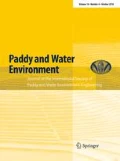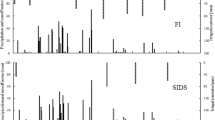Abstract
Improper application of nitrogen (N) has led to high N losses and low N use efficiency in the lower reaches of Yangtze River in China. An effective method to solve such problems is the deep fertilized N in root zone (RZF). Limited information is available on the effect of RZF on the uptake of macronutrients (N, P and K) and rice yield. Field experiments, conducted from 2014 to 2015, compared the farmer fertilizer practice (FFP, with 225 kg ha−1 of N, split into three doses) and RZF using the same rate but placing N 5 cm away from rice roots in holes 10 cm deep (RZF10) or 5 cm deep (RZF5) as a single application. The highest mean yield (10.0 t ha−1) was obtained in RZF10, which was 19.5% more than that in FFP. Root zone fertilization of urea (whether 10 cm deep or 5 cm deep) resulted in greater accumulation of N, P and K in stem, leaf sheaths, leaf blades and grains compared to that in FFP in sandy and in loam soils. The uptake of N, P and K was the highest in RZF10 (average at 176.7, 66.2 and 179.1 kg ha−1, respectively), higher than that in FFP by 45.0, 17.0 and 22.6%, respectively. N apparent recovery efficiency was markedly higher in RZF10 (53.1%) than in FFP (27.5%). RZF10 significantly increased the N, P, K uptake compared with FFP under different N rates in both sandy and loam soils. These results suggest that the N, P and K input amount should be re-determined under RZF.






Similar content being viewed by others
References
Alfoldi Z, Pinter L, Feil B (1994) Nitrogen, phosphorus and potassium concentrations in developing maize grains. J Agron Crop Sci 172:200–206
Azam MG, Mahmud JA, Ahammad KU, Gulandaz MA, Islam M (2012) Proficiency and profitability of potato as affected by urea super granule (USG) as a source of nitrogen in high Ganges river floodplain of Bangladesh. Int J Sustain Crop Prod 7:28–30
Barison J, Uphoff N (2011) Rice yield and its relation to root growth and nutrient-use efficiency under SRI and conventional cultivation: an evaluation in Madagascar. Paddy Water Environ, 9:65–78. doi:10.1007/s10333-010-0229-z
Cao YS, Tian YH, Yin B, Zhu ZL (2013) Assessment of ammonia volatilization from paddy fields under crop management practices aimed to increase grain yield and N efficiency. Field Crops Research 147:23–31. doi:10.1016/j.fcr.2013.03.015
Cormier N, Twilley RR, Ewel KC, Krauss KW (2015) Fine root productivity varies along nitrogen and phosphorus gradients in high-rainfall mangrove forests of Micronesia. Hydrobiologia 750:69–87. doi:10.1007/s10750-015-2178-4
Dass A, Chandra S (2013) Panicle characteristics, yield and their correlation in system of rice (Oryza sativa) intensification and conventional transplanting under variable irrigation, spacing and varieties. Indian J Agron 58:54–62
Dass A, Suri VK, Choudhary AK (2014) Site-specific nutrient management approaches for enhanced nutrient-use efficiency in agricultural crops. J Crop Sci Technol 3:1–6
Dass A, Kaur R, Choudhary AK, Pooniya V, Raj R, Rana KS (2015) System of rice (Oryza sativa) intensification for higher productivity and resource use efficiency—a review. Indian J Agron 60:1–19
Fageria NK, Morais OP, Santos AB (2010) Nitrogen use efficiency in upland rice genotypes. J Plant Nutr 33:1696–1711. doi:10.1080/01904167.2010.496892
Guo JH, Liu XJ, Zhang Y, Shen JL, Han WX, Zhang WF, Christie P, Goulding KW, Vitousek PM, Zhang FS (2010) Significant acidification in major Chinese croplands. Science 327:1008–1010. doi:10.1126/science.1182570
Hussain MJ, Ali MY, Rahman MA, Quayyum MA, Choudury DA (2010) Effect of urea super granule on the performance of cabbage in young Jamuna and Brahmaputra floodplain soils of Tangail. Bangladesh J Agric Res 35:267–272
Ju XT, Xing GX, Chen XP, Zhang SL, Zhang LJ, Liu XJ, Cui ZL, Yin B, Christie P, Zhu ZL, Zhang FS (2009) Reducing environmental risk by improving N management in intensive Chinese agricultural systems (vol 106, pg 3041, 2009). Proc Natl Acad Sci USA. doi:10.1073/pnas.0902655106
Kai MU, Larsen TA, Biebow M, Gujer W (2003) Urea hydrolysis and precipitation dynamics in a urine-collecting system. Water Res 37:2571–2582
Kapoor V, Singh U, Patil SK, Magre H, Shrivastava LK, Mishra VN, Das RO, Samadhiya VK, Sanabria J, Diamond R (2008) Rice growth, grain yield, and floodwater nutrient dynamics as affected by nutrient placement method and rate. Agron J 100:526. doi:10.2134/agronj2007.0007
Li H, Liu L, Wang Z, Yang J, Zhang J (2012) Agronomic and physiological performance of high-yielding wheat and rice in the lower reaches of Yangtze River of China. Field Crops Research 133:119–129. doi:10.1016/j.fcr.2012.04.005
Li JF, Ren T, Lu JW, Cong RH, Li XK, Ma XX (2013) Study on characteristics of release and distribution of rice straw potassium and chemical potassium by lab simulation. Soils 45:1017–1022
Okuno A, Hirano K, Asano K, Takase W, Masuda R, Morinaka Y, Ueguchi-Tanaka M, Kitano H, Matsuoka M (2014) New approach to increasing rice lodging resistance and biomass yield through the use of high gibberellin producing varieties. PLoS ONE 9:e86870. doi:10.1371/journal.pone.0086870
Peng SB, Buresh RJ, Huang JL, Zhong XH, Zou YB, Yang JC, Wang GH, Liu YY, Hu RF, Tang QY, Cui KH, Zhang FS, Dobermann A (2010) Improving nitrogen fertilization in rice by site-specific N management: a review. Agron Sustain Dev 30:649–656. doi:10.1051/agro/2010002
Qi XL, Nie LX, Liu HY, Peng SB, Shah F, Huang JL, Cui KH, Sun LM (2012) Grain yield and apparent N recovery efficiency of dry direct-seeded rice under different N treatments aimed to reduce soil ammonia volatilization. Field Crops Res 134:138–143. doi:10.1016/j.fcr.2012.05.010
Rochette P, Angers DA, Chantigny MH, Gasser MO, MacDonald JD, Pelster DE, Bertrand N (2013) Ammonia volatilization and nitrogen retention: how deep to incorporate urea? J Environ Qual 42:1635–1642. doi:10.2134/jeq2013.05.0192
Salam M, Solaiman ARM, Karim AJMS, Saleque MA (2014) System productivity, nutrient use efficiency and apparent nutrient balance in rice-based cropping systems. Arch Agron Soil Sci 60:747–764. doi:10.1080/03650340.2013.849805
Savant NK, Stangel PJ (1990) Deep placement of urea supergranules in transplanted rice–principles and practices. Fertil Res 25:1–83. doi:10.1007/Bf01063765
Shen XL, Diao FB, Jiang ZM, Duan YH, Jiang HG (2011) Characteristics of Wuyunjing 24 and high yield cultural techniques under mechanized transplanting. China Rice 17:63–64
Shi JG, Liu JG, Chen F, Chu QQ (2012) Researches on rice yield gaps and their distribution characterisitcs in middle and lower area of Yangtze River Valley. J China Agric Uni 17:33–39
Su TQ, Wang HY, Zhou JM, Chen XQ, Du CW (2011) Transformation and movement of potassium in Ferti-sphere of paddy soil as affected by co-application of ammonium. Soils 43:367–373
Su JQ, Ding LJ, Xue K, Yao HY, Quensen J, Bai SJ, Wei WX, Wu JS, Zhou J, Tiedje JM, Zhu YG (2015a) Long-term balanced fertilization increases the soil microbial functional diversity in a phosphorus-limited paddy soil. Mol Ecol 24:136–150. doi:10.1111/mec.13010
Su W, Liu B, Liu XW, Li XK, Ren T, Cong RH, Lu JW (2015b) Effect of depth of fertilizer banded-placement on growth, nutrient uptake and yield of oilseed rape (Brassica napus L.). Eur J Agron 62:38–45. doi:10.1016/j.eja.2014.09.002
Sun AW, Zhang WF, Du F, Gao LW, Zhang FS, Chen XP (2009) China’ s development strategy on potash resources and fertilizer. Mod Chem Ind 29:10–16
Wang HY, Zhou JM (2015) Root-zone fertilization a key and necessary approach to improve fertilizer use efficiency and reduce non-point source pollution from the cropland. Soils 45:785–790
Wijesinghe DK, John EA, Beurskens S, Hutchings MJ (2002) Root system size and precision in nutrient foraging: responses to spatial pattern of nutrient supply in six herbaceous species. J Ecol 89:972–983
Xiang J, Handen VR, Peng SB, Bouman BAM, Huang JL, Cui KH, Visperas RM, Zhu DF, Zhang YP, Chen HZ (2013) Effect of deep placement of nitrogen fertilizer on growth, yield, and nitrogen uptake of aerobic rice. Aust J Crop Sci 7:870–877
Yan C, Zhan H, Yan S, Dong S, Ma C, Song Q, Gong Z, Barbie M (2016) Effects of straw retention and phosphorous fertilizer application on available phosphorus content in the soil solution during rice growth. Paddy Water Environ, 14:61–69. doi:10.1007/s10333-015-0478-y
Zhang CF, Peng SB, Peng XX, Chavez AQ, Bennett J (1997) Response of glutamine synthetase isoforms to nitrogen sources in rice (Oryza sativa L.) roots. Plant Sci 125:163–170. doi:10.1016/S0168-9452(97)00075-7
Zhao X, Zhou Y, Wang S, Xing G, Shi W, Xu R, Zhu Z (2012) Nitrogen Balance in a Highly Fertilized Rice-Wheat Double-Cropping System in Southern China. Soil Sci Soc Am J 76:1068–1078
Acknowledgements
This work was supported by the Major State Basic Research Development Program of China (Grant No. 2013CB127401), the National Department Public Benefit Research Foundation of China (Grant No. 201203013), the National Natural Science Foundation of China (Grant Nos. 41271309) and the program of the 13th Five-Year Plan in the Institute of Soil Science, Chinese Academy of Sciences (ISSASIP1649). We thank FQ Hu, T Ling, YZ Liu, ST Jiang, XL Zhao and YL Wang for their help with the experiments and two anonymous reviewers for helpful comments on the manuscript.
Author information
Authors and Affiliations
Corresponding author
Ethics declarations
The authors have declared that no competing interests exist.
Rights and permissions
About this article
Cite this article
Liu, X., Wang, H., Zhou, J. et al. Effect of nitrogen root zone fertilization on rice yield, uptake and utilization of macronutrient in lower reaches of Yangtze River, China. Paddy Water Environ 15, 625–638 (2017). https://doi.org/10.1007/s10333-017-0581-3
Received:
Revised:
Accepted:
Published:
Issue Date:
DOI: https://doi.org/10.1007/s10333-017-0581-3




